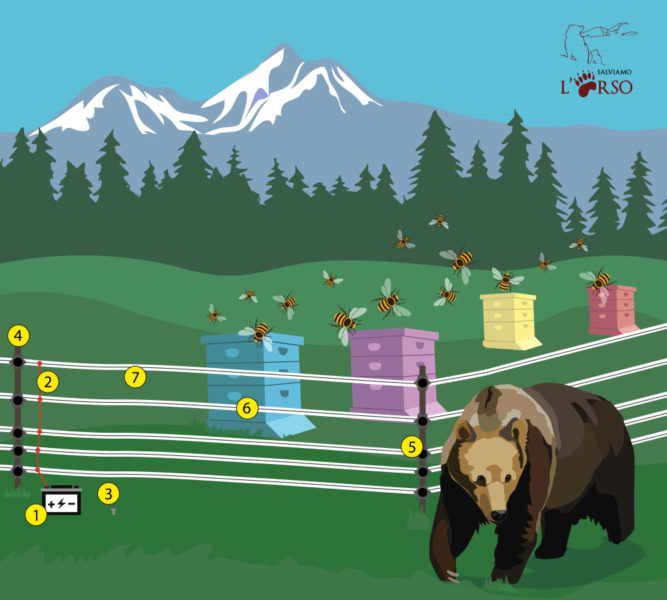Guidelines for Electric fences
translated by Clara Bori
Farm animals, domestic livestock, fruit, vegetables, bee larvae and honey are a food source for bears which, as opportunistic predators, can benefit just as much as these rural activities in areas that are naturally suitable for this species. At present, just a few individuals (5 or 6, which is about 10% of the estimated bear population), have evidenced behaviour considered “problematic”, attacking urban farms and orchards and occasionally sparking conflict with local stakeholders who do not recognise bears the right to fulfill their biological role in areas claimed exclusively for human use.
However, it is usually due to the unconsciousness and negligence of the people, who fail to protect their farm animals and who leave carcasses and tempting waste material close to the sheds, that bears and other wild animals approach and the associated damages and conflicts arise. Prevention systems such as electric fences,bear-proof doors, bear-proofhenhouses and bear-proofbins are aimed at preventing bears from becoming used to raiding anthropogenic food sources, whereby they obtain not only food but also the validation of their behaviour.
Electric fences serve as psychological barriers that prevent bears from entering farms and gardens.
In order to channel electricity in a prevention system, there must be a complete closed circuit. Electric current travels from its source into the circuit and vice versa. Such flow occurs only with the grounding of an electrically loaded wire of the fence. Typically, the electric fence functions as an open or incomplete circuit and a generator creates and repeats electric pulses, which are then transmitted to the electric wires of the prevention system. When a bear touches a wire, it grounds the system and thus closes the circuit. The electric pulse passes through the animal and goes back to the generator, producing a shock that is unpleasant but not deadly.
It has been shown that electric fences are approximately 100% effective. Those who are not acquainted with this protective device usually worry that they or their dogs may get injured, permanently damaged or electrocuted. Wrong! When correctly built, electric fences are safe for people, their animals and bears. They are relatively easy to set up. However, it is advisable to follow the instructions attentively or to reach out to the technicians in the protected areas or in our association to receive guidance on how to avoid malfunction and impairment.
It is recommended that a total of 5 lines of electric wire is put in place, in accordance with Life Arctos project guidelines. When constructing the electric fence, the first three lines of wire must be placed 20 cm from each other and start 20 cm from the ground. The last two lines should be at a distance of 30 cm from each other, for a total fence height of 120 cm. This is sufficient to prevent possible intrusion from bears.
A Voltmeter or Joulemeter should be used to measure the efficiency and effectiveness of the system.
Video tutorial: how to build an electrified fence
Other systems to prevent damage
- Stables, chicken coops and brick shelters can be made bear-proof by installing metal doors/windows or lockable iron grates and reinforcing roofs (metal fixed to the edges or concrete roofs);
- Possible use of acoustic deterrents, with the advice of protected areas’ authorities;
- Bear-proof chicken coops made using metal plates, recently prepared and tested by the Abruzzo, Lazio & Molise National Park according to animal welfare standards.
Please write to info@salviamolorso.it if you need any assistance.

The essential components of the electric fence are as follows:
- Fence Energiser at least 0.8-1 Joule (2-3 Joules is recommended) and pulse with minimum tension of 5,000 Volts (possibly between 8,000 and 10,000). The energizer can be powered by a home power grid or by 9-12 Volts batteries which work well in conjunction with a solar panel;
- Connection bolts from the energiser to the fence;
- Earth stake with connective wire to the energiser;
- Fence wooden posts 6-8 cm in diameter, placed at the corners of the fencing or at the gate (composed of electric spring gates with insulated handle), best if reinforced by corner counterthrust posts. The posts should be installed 4-5 m apart. Wooden posts should be used for permanent fencing, while for mobile fencing posts made of plastic or other material are acceptable;
- Insulators, generally plastic tools to insulate the electric wire from the posts. They are not needed if plastic posts are used;
- Fence wire (tape) 16-20 cm wide for mobile fencing and/or metal wiring of 1.5 mm diameter for fixed fencing.
- Fence warning sign indicating that electric fencing is in use.











